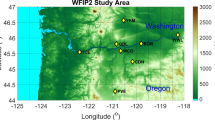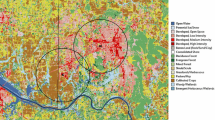Abstract
A comprehensive planetary boundary-layer (PBL) and synoptic data set is used to isolate the mechanisms that determine the vertical shear of the horizontal wind in the convective mixed layer. To do this, we compare a fair-weather convective PBL with no vertical shear through the mixed layer (10 March 1992), with a day with substantial vertical shear in the north-south wind component (27 February). The approach involves evaluating the terms of the budget equations for the two components of the vertical shear of the horizontal wind; namely: the time-rate-of-change or time-tendency term, differential advection, the Coriolis terms (a thermal wind term and a shear term), and the second derivative of the vertical transport of horizontal momentum with respect to height (turbulent-transport term). The data, gathered during the 1992 STorm-scale Operational and Research Meteorology (STORM) Fronts Experiments Systems Test (FEST) field experiment, are from gust-probe aircraft horizontal legs and soundings, 915-MHz wind profilers, a 5-cm Doppler radar, radiosondes, and surface Portable Automated Mesonet (PAM) stations in a roughly 50 × 50 km boundary-layer array in north-eastern Kansas, nested in a mesoscale-to-synoptic array of radiosondes and surface data.
We present evidence that the shear on 27 February is related to the rapid growth of the convective boundary layer. Computing the shear budget over a fixed depth (the final depth of the mixed layer), we find that the time-tendency term dominates, reflecting entrainment of high-shear air from above the boundary layer. We suggest that shear within the mixed layer occurs when the time-tendency term is sufficiently large that the shear-reduction terms – namely the turbulent-transport term and differential advection terms – cannot compensate. In contrast, the tendency term is small for the slowly-growing PBL of 10 March, resulting in a balance between the Coriolis terms and the turbulent-transport term. Thus, the thermal wind appears to influence mixed-layer shear only indirectly, through its role in determining the entrained shear.
Similar content being viewed by others
References
Angevine, W. M., White, A. B., and Avery, S. K.: 1994, ‘Boundary Layer Depth and Entrainment Zone Characterization with a Boundary Layer Profiler’, Boundary-Layer Meteorol. 68, 375–385.
Bannon, P. R. and Salem, T. L., Jr.: 1995, ‘Aspects of the Baroclinic Boundary Layer’, J. Atmos. Sci. 52, 574–596.
Brown, A. R.: 1996, ‘Large-Eddy Simulation and Parameterization of the Baroclinic Boundary-Layer’, Quart. J. Roy. Meteorol. Soc. 122, 1779–1798.
Byers, H.: 1959, General Meteorology, Third Edition, McGraw-Hill Book Co., New York, NY, 540 pp.
Browning, K. A. and Wexler, R.: 1968, ‘The Determination of Kinematic Properties of a Wind Field using Doppler Radar’, J. Appl. Meteorol. 7, 105–113.
Businger, J. A., Dabberdt, W. F., Delaney, A. C., Horst, T. W., Martin, C. L., Oncley, S. P., and Semmer, S. R.: 1990, ‘The NCAR Atmosphere-Surface Turbulent Exchange Research (ASTER) Facility’, Bull. Amer. Meteorol. Soc. 71, 1004–1011.
Caughey, S. J. and Palmer, S. G.: 1979, ‘Some Aspects of Turbulence Structure Through the Depth of the Convective Boundary Layer’, Quart. J. Roy. Meteorol. Soc. 105, 811–827.
Clark, T. L., Hauf, T., and Kuettner, J. P.: 1986, ‘Convective-Forced Internal Gravity Waves: Results from Two-Dimensional Experiments’, Quart. J. Roy. Meteorol. Soc. 112, 899–926.
Crawford, K. C. and Hudson, H. R.: 1970, Behavior of Winds in the Lowest 1500 feet in Central Oklahoma: June 1966–May 1967, ESSA Technical Memorandum ERTLM-NSSL 48.
Deardorff, J. W.: 1972, ‘Numerical Investigations of Neutral and Unstable Planetary Boundary Layers’, J. Atmos. Sci. 29, 91–115.
Geisler, J. E. and Kraus, E. B.: 1969, ‘The Well-Mixed Ekman Boundary Layer’, Deep Sea Research 16(Suppl.), 73–84.
Gray, W. M.: 1972, A Diagnostic Study of the Planetary Boundary Layer over the Oceans, Atmos. Sci. Paper No. 179. 95 pp., Colorado State University, Ft. Collins, CO.
Gray, W. M. and Mendenhall, B. R.: 1973, ‘A Statistical Analysis of Factors Influencing the Wind Veering in the Planetary Boundary Layer’, Bonner Meteorol. Abhandl. 17, 167–194.
Grossman, R. L.: 1977, ‘A Procedure for the Correction of Biases in Winds Measured from Aircraft’, J. Appl. Meteorol. 6, 654–658.
Hoxit, L. R.: 1974, ‘Planetary Boundary Layer Winds in Baroclinic Conditions’, J. Atmos. Sci. 31, 1003–1020.
Kaimal, J. C., Wyngaard, J. C., Haugen, D. A., Cote, O. R., Izumi, Y., Caughey, S. J., and Readings, C. J.: 1976, ‘Turbulence Structure in the Convective Boundary Layer’, J. Atmos. Sci. 33, 2152–2169.
Kraus, E. B.: 1972, Atmosphere-Ocean Interaction, Oxford Monographs on Meteorology, Clarendon Press, Oxford, 275 pp.
Kustas, W. P. and Brutsaert, W.: 1987, ‘Budgets of Water Vapor in the Unstable Boundary Layer over Rugged Terrain’, J. Clim. Appl. Meteorol. 26. 607–620.
Lilly, D. K.: 1968, ‘Models of Cloud-Topped Mixed Layers under a Strong Inversion’, Quart. J. Roy. Meteorol. Soc. 94, 292–309.
Lenschow, D. H., Wyngaard, J. C., and Pennell, W. T.: 1980, ‘Mean Field and Second Moment Budgets in a Baroclinic, Convective Boundary Layer’, J. Atmos. Sci. 37, 1313–1326.
Malkus, J. S.: 1958: On the Structure of the Trade Wind Moist Layer, Papers Phys. Ocean. Meteorol., Vol. 13, Woods Hole Ocean. Inst., 47 pp.
Mann, J. and Lenschow, D. H.: 1994, ‘Errors in Airborne Flux Measurements’, J. Geophys. Res. 99, 14,519–14,526.
Mendenhall, B. R.: 1967, A Statistical Study of the Frictional Wind Veering in the Planetary Boundary Layer, Paper. No. 116, Colorado State University, Ft. Collins, CO.
Mildner, P.: 1932:, ‘Über die Reibung in Einer Speziellen Luftmasse in den Untersten Schichten der Atmosphäre’, Beitr. Phys. d. freien Atmos. 19, 151.
Moeng, C.-H. and Sullivan, P. P.: 1994, ‘A Comparison of Shear-and Buoyancy-Driven Planetary Boundary Layer Flows’, J. Atmos. Sci. 51, 999–1022.
Nicholls, S. and LeMone, M. A.: 1980, ‘The Fair Weather Boundary Layer in GATE: The Relationship of Subcloud Fluxes and Structure to the Distribution and Enhancement of Cumulus Clouds’, J. Atmos. Sci. 37, 2051–2067.
Riehl, H., Yeh, T. C., Malkus, J. S., and LaSeur, N. E.: 1951, ‘The North-East Trade of the Pacific Ocean’, Quart. J. Roy. Meteorol. Soc. 77, 598–626.
Strauch, R. G., Weber, B. L., Frisch, A. S., Little, C. G., Merritt, D. A., Moran, K. P., and Welsh, D. C.: 1987, ‘The Precision and Relative Accuracy of Profiler Wind Measurements’, J. Atmos. Oceanic Tech. 4, 563–571.
Stull, R. B.: 1985, ‘A Fair Weather Cumulus Classification Scheme Useful for Mixed Layer Studies’, J. Climate Appl. Meteorol. 24, 49–56.
Stull, R. B.: 1988, An Introduction to Boundary Layer Meteorology, Kluwer Academic Publishers, Boston, 666 pp.
Weber, B. L., Wuertz, D. B., Welsh, D. C., and McPeek, R.: 1993, ‘Quality Controls for Profiler Measurements of Winds and RASS Temperatures’, J. Atmos. Oceanic. Tech. 10, 452–464.
Wilson, J. W., Weckwerth, T. M., Vivekanandan, J., Wakimoto, R. M., and Russell, R. W.: 1994, ‘Boundary Layer Clear-Air Echoes and Accuracy of Derived Winds’, J. Atmos. Oceanic. Tech. 11, 1184–1206.
Wyngaard, J. C.: 1984, ‘Toward Convective Boundary Layer Parameterization: A Scalar Transport Module’, J. Atmos. Sci. 41, 1959–1969.
Wyngaard, J. C., and LeMone, M. A.: 1980, ‘Behavior of the Refractive Index Structure Parameter in the Entraining Convective Boundary Layer’, J. Atmos. Sci. 37, 1573–1585.
Zhou, M. Y., Lenschow, D. H., Stankov, B. B., Kaimal, J. C., and Gaynor, J. E.: 1985, ‘Wave and Turbulence Structure in a Shallow Baroclinic Connective Boundary Layer and Overlying Inversion’, J. Atmos. Sci. 42, 47–57.
Author information
Authors and Affiliations
Rights and permissions
About this article
Cite this article
Lemone, M.a., Zhou, M., Moeng, CH. et al. An Observational Study of Wind Profiles in the Baroclinic Convective Mixed Layer. Boundary-Layer Meteorology 90, 47–82 (1999). https://doi.org/10.1023/A:1001703303697
Issue Date:
DOI: https://doi.org/10.1023/A:1001703303697




